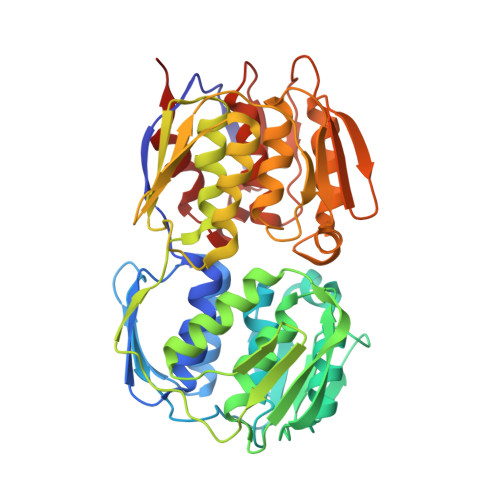Structural basis of glyphosate tolerance resulting from mutations of Pro101 in Escherichia coli 5-enolpyruvylshikimate-3-phosphate synthase.
Healy-Fried, M.L., Funke, T., Priestman, M.A., Han, H., Schonbrunn, E.(2007) J Biological Chem 282: 32949-32955
- PubMed: 17855366
- DOI: https://doi.org/10.1074/jbc.M705624200
- Primary Citation of Related Structures:
2QFQ, 2QFS, 2QFT, 2QFU - PubMed Abstract:
Glyphosate, the world's most used herbicide, is a massive success because it enables efficient weed control with minimal animal and environmental toxicity. The molecular target of glyphosate is 5-enolpyruvylshikimate-3-phosphate synthase (EPSPS), which catalyzes the sixth step of the shikimate pathway in plants and microorganisms. Glyphosate-tolerant variants of EPSPS constitute the basis of genetically engineered herbicide-tolerant crops. A single-site mutation of Pro(101) in EPSPS (numbering according to the enzyme from Escherichia coli) has been implicated in glyphosate-resistant weeds, but this residue is not directly involved in glyphosate binding, and the basis for this phenomenon has remained unclear in the absence of further kinetic and structural characterization. To probe the effects of mutations at this site, E. coli EPSPS enzymes were produced with glycine, alanine, serine, or leucine substituted for Pro(101). These mutant enzymes were analyzed by steady-state kinetics, and the crystal structures of the substrate binary and substrate.glyphosate ternary complexes of P101S and P101L EPSPS were determined to between 1.5- and 1.6-A resolution. It appears that residues smaller than leucine may be substituted for Pro(101) without decreasing catalytic efficiency. Any mutation at this site results in a structural change in the glyphosate-binding site, shifting Thr(97) and Gly(96) toward the inhibitor molecule. We conclude that the decreased inhibitory potency observed for glyphosate is a result of these mutation-induced long-range structural changes. The implications of our findings concerning the development and spread of glyphosate-resistant weeds are discussed.
- Department of Medicinal Chemistry, University of Kansas, Lawrence, KS 66045, USA.
Organizational Affiliation:



















